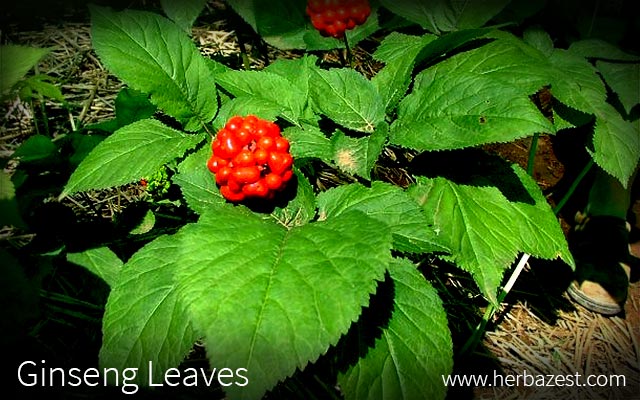Many people believe that ginseng root is the best source of all of ginseng health benefits, but studies have shown that the leaves of the Panax species are just as effective. Learn more about ginseng leaves benefits and characteristics, as well as how to make ginseng tea from leaves.
Appearance of Ginseng Leaves
Each Panax plant has leaves that grow from shriveled, closed plants to open, fully-developed leaves, and their appearance is slightly different depending on the types of ginseng.
Panax ginseng. A young Asian or Korean ginseng plant has three oval leaflets with double-toothed borders. The plant will grow additional three to five leaflets per leaf as it matures. The leaves are dark green in the spring and vibrant yellow in the autumn.
Wild ginseng. The mature wild ginseng, or American ginseng (P. quinquefolius), is arranged in a whorl with three or four compound leaves, each with two to four inches (5 - 10 cm) long leaflets, the upper three larger than the lower two. The leaves are bright green in the summer and yellow in the autumn.
Harvesting Ginseng Leaves
Growing and harvesting ginseng leaves requires a great deal of patience, as the maturing process for the ginseng plant can take up to six years.
Most of ginseng leaves benefits are attributed to their outstanding levels of ginsenosides, which are the bioactive compounds thought to be responsible for Panax plants medicinal actions. As the leaves grow, the level of ginsenosides increases, and therefore so does the overall value of the leaves.
The best time to harvest ginseng leaves is at maturation, typically after about five years, in the middle of September, before they turn yellow.
Preparations with Ginseng Leaves
Ginseng leaves are mainly used for medicinal purposes. As a remedy for a variety of health issues, ginseng leaves can be prepared as:
Extracts. Ginseng leaf extraction is one of the most popular ways to prepare the leaves. The extract can be made at home easily and has many uses. A few of the main benefits include anti-fatigue, anti-hyperglycemic, anti-obesity, and anti-aging properties.
Teas. Dried young ginseng leaves can be stepped for about five minutes in hot water to obtain a medicinal infusion, which provides all the stimulating properties of the plant. This soothing tea, without added sugars, has a very pleasant taste, and it is inexpensive.
Ginseng leaves for sale can be found dried, in bulk form or practical teabags, alone or mixed with other herbs, in any herbal store, supermarket, or online retailer, so their medicinal properties are available all year around.
Ginseng Leaves Benefits
Since ginseng leaves are such a great source of ginsenosides, they have been subject of scientific research, and have been shown to be beneficial for human health.
A study published in Pharmacological Research (2004) found that ginseng leaves possess significant hypoglycemic properties and could help people with type 2 diabetes.
On the other hand, a study published in The American Journal of Chinese Medicine (2009) found that ginseng leaves also have multifaceted pharmacological effects on the central nervous system, as well as on the cardiovascular, reproductive, and metabolic systems.
In addition, ginseng leaves may help protect the skin against ultraviolet-induced damage, according to a study published in Biotechnology and Applied Biochemistry, in 2014.
Ginseng leaves are not only just as beneficial to human health as the ginseng berries or the Panax root, but they are even easier to find and cheaper. Ginseng leaves are a valuable source of ginsenosides and are a great option to reap all the benefits of the ginseng herb.
Sources
- Biotechnology and Applied Biochemistry, Protective effects of ginseng leaf extract using enzymatic extraction against oxidative damage of UVA-irradiated human keratinocytes, 2014
- Journal of Ginseng Research, How to Find, Grow, and Use America’s Forest Gold, 1995
- Life Science Journal, Ginsenoside Content in The Leaves and Roots of Panax ginseng at Different Ages, 2012
- Pharmacological Research, American ginseng leaf: ginsenoside analysis and hypoglycemic activity, 2004
- The American Journal of Chinese Medicine, Ginseng leaf-stem: bioactive constituents and pharmacological functions, 2009
- Kew Royal Botanic Gardens, Panax quinquefolius (American ginseng)
- Analytical and Bioanalytical Chemistry, Isolation and determination of ginsenosides in American ginseng leaves and root extracts by LC-MS, 2005




